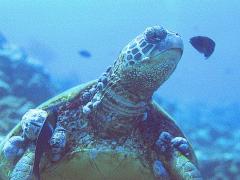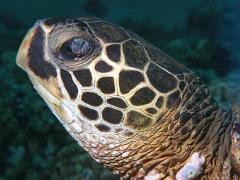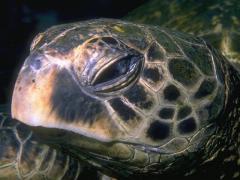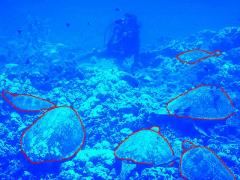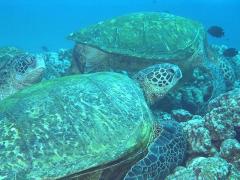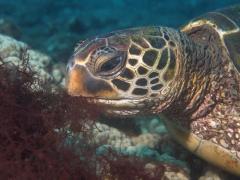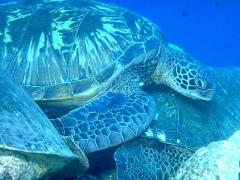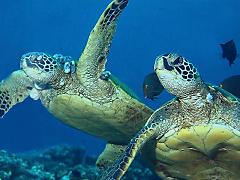Fibropapilloma Tumors at Honokowai
Underwater observations with potential broad application
|
|
|
Dedicated to Howzit, a friend of ours since 1992. The picture on the left is from 1994, and the one on the right was taken in 1995. Note the increase in tumors and the concave plastron. The progression of the tumors was so rapid that we did not expect to see Howzit in 1996--and we didn't. |
Ed. note: This essay was originally posted on December 17, 1995. The format of this page has been modified since then, and the content of the essay has been slightly modified to reflect the new formatting. The core information, however, has remained untouched. Some of the material in this essay has become outdated with progress in the research concerning fibropapilloma, and also with our own continuing education about the disease. The essay remains here for context.
"Pollution, right?"
That is the first reaction of nearly everyone who sees our images of tumored turtles. If only it were that simple.
No one really knows what causes turtle tumors. Although scientists have made progress towards understanding fibropapillomas, the cause is still uncertain. Until someone finds the cause, no one can know how tumors spread. This makes it difficult--but not impossible--to know what to do about the disease.
We reached this conclusion after reading many scientific papers, consulting Internet sources, and soliciting information through email from marine turtle specialists, virologists, government officials, and fellow divers.
Note that we did not say fellow scientists. Scientists we are not. We are turtle-watchers. We have eight summers of observations in the waters of Honokowai, West Maui. Over that time, we have done nearly 1000 dives averaging about 75 minutes each, with 35-40 of those minutes spent actually watching turtles. We have made over 90 hours of videotape and taken over 2500 photographs. We have paid close attention to watching and documenting the changes in the environment. We have developed a reliable method of identifying individual turtles--over 100 of them so far--allowing us to track the changes in their condition from year to year.
Since we first discovered the turtles of Honokowai and their tumors, we have frequently been asked to explain the problem. When we tell people that science is still searching for the answers, we are next pressed for our opinion. Because we now maintain Turtle Trax, a page dedicated to spreading information about marine turtles, we felt a need to make sure that whatever opinions we expressed were solidly based.
We have therefore spent considerable time trying to make sense of what we have seen and learned. From our observations and the inquiries they prompted, we think we have a plausible explanation of the dynamics of the disease and its transmission. Certainly it explains our observations and many of the points raised by researchers in the papers we've studied.
We have no doubt that our explanation is incomplete and probably wrong in some areas. Nevertheless, it does fit the facts we've gathered from various papers, as well as our personal observations underwater. We believe that if we are correct, we can identify potential hot-spots, where the incidence of tumors will be exceptionally high--50% and higher.
In this essay, we show how our thinking arose from our observations and inquiries about our Honokowai dive site, and explain why we believe it can explain aspects of the development of the fibropapilloma tumors worldwide.
Throughout this essay, you see links to the footnotes. These are links of the type [n], where n is a number, which take you to our page of footnotes. This page gives the source of the information used to make a particular point, including the pertinent quote. If the referenced document is available on the Web, there is a link directly to it.
Consider the following points:
- Seaweeds, like any algae, respond to nutrients[1]. If you allow extra nutrients into a shallow coastal area, one where they will not be quickly diluted and carried off, you will get increased seaweed growth.
- Sea turtles, like other animals, tend to cluster at places where food is most plentiful. Green sea turtles feed primarily on various seaweeds[2]. It seems likely that if you find an area of abundant seaweed, you will find more turtles than you would in areas with less seaweed.
- When the turtle population density increases, there is more contact between individual turtles, and each turtle has contact with a larger number of other turtles. This provides more opportunities for the spread of communicable disease[3].
Turtles In Touch
This is a typical gathering of turtles at a part of our dive area that we call the Resting Site. This summer, we usually found three to five turtles here. It is Raphael's favourite place, and she is frequently joined there by Estrelita, Hilu, and Nani.
The Honokowai turtles seem to prefer being close together, and often end up touching one another to some degree. In this picture, Hilu is lying on the left side of Raphael's carapace.
|
- Fibropapilloma tumors are almost certainly spread by a virus. Although the virus has not yet been isolated, fibropapillomas are virus-induced in other animals[4]. Dr. Larry Herbst, Dr. Elliot Jacobson, Dr. Paul Klein, and others have strongly implicated a viral cause[5] and are working towards conclusive proof.
- Viruses can be spread through mechanical vectors[6,7]. When turtles gather in sufficient numbers[8], some fish will become cleaners. Each one is a potential vector[9].
Suspected Mechanical Vectors
The cleaners in this image, goldring surgeons (Ctenochaetus strigosus), are clearly grazing on the tumors. Much more likely suspects, however, are saddleback wrasses (Thalassoma duperrey), such as the one in the upper left portion of the photo.
Four Spot, the turtle in this picture, was free of tumors in 1992.
|
Let's first examine how these points apply to the turtles of Honokowai.
Around 500 metres to the north of where we watch these turtles, there is the Mahinahina Channel, part of the Honoloua Watershed Project. This is a concrete channel built for flood and erosion control. At roughly the same distance to the south, there is the Honokowai Stream Channel, also concrete. Runoff from pineapple and sugar cane fields collects in these channels and until recently, was discharged right into the ocean.
Just over a kilometre south and about 500 metres from the shoreline, the Lahaina Wastewater Reclamation Facility uses injection wells to dispose of sewage effluent. Into holes ranging from 55 to 70 metres deep, contained only by concrete casings extending approximately 45% of their depth, Maui County pumps effluent at a rate of 15-25 millions of litres per day. Maui, of course, is a volcanic island, with plenty of porous rock and lava tubes. Where has this effluent been going? No one knows, but it seems extremely unlikely that none of it ever reached the ocean.
The waters of West Maui near Honokowai are shallow and do not appear to lend themselves readily to self-cleansing. When Tropical Storm Dora passed by on July 22, 1993, about two hours of heavy rain sent countless litres of runoff down the two concrete channels. This runoff was characterized by silt that left a muddy band along the coastline, stretching 100 metres and more from the waterline. Despite wave and current action, this band persisted until well into November, providing a graphic demonstration of how long it can take to disperse material that enters the ocean in this area.
No one tested this runoff, but since the channels both reach far back from the shoreline into agricultural areas, it is hard to believe that this mud was not loaded with nutrients above and beyond its natural levels, which already would be high enough to disrupt the underwater environment.
This is only the most obvious example of what has been happening to the waters of Honokowai. In 1989 and 1991, there were enormous blooms of Cladophora sericea, a seaweed usually found in deeper water. Since 1989, hooked red hypnea has been establishing itself in the same area, and now is a permanent feature along Honokowai, piling up on shore and floating in huge mats.
Blooming Seaweed
This image is captured from videotape made in July 1991. Great clouds of Cladophora floated through the waters of Honokowai, snagging on corals and choking them to death. In many places, Cladophora collected in depths of one to two metres.
|
Underwater, a former garden of low corals has become choked and overgrown with seaweeds. The northern portion of our dive site no longer has living corals in the 4-6 metre depths. As early as 1985, George Balazs documented that the southern portion of our dive site already had dense algae growth.[10] This suggests that the area was already receiving significant nutrient input well before the blooms of 1989 and 1991.
Honokowai has more seaweed in its waters than do the areas both to the north and south. Because there is so much food readily available, turtles should be more common at Honokowai than on the neighbour reefs. This has, in fact, been our experience. Communications with others who dive West Maui tend to confirm this, although no one has undertaken a thorough turtle census.
Too Much Of A Good Thing?
Despite seeming to be a wonderful foraging site for turtles, this is a place we call The Graveyard. It is a long finger-like depression that drops about 1.5 m below the surrounding floor, bottoming out at about 8 m below the surface. Most of the time there is a mat of algae accumulating here, nearly deep enough to cover a 75 cm turtle. In this mat, we usually see two or three turtles. Every year, they are among the worst tumor cases we see. Because of this, each summer the cast at The Graveyard is different.
We have never observed cleaning activity at this site, and the algae covering the turtles we see there indicates that they rarely attend a cleaning station. Since the biting of wrasses and tobies is painful, we believe that these severely afflicted turtles deliberately avoid cleaners.
The Graveyard has abundant seaweeds and is shallow, meaning the turtle has to expend as little energy as possible to get food and air.
|
We might not be able to say exactly how many there are, but by observing the behaviour of the Honokowai turtles, we have learned a number of things about them. For example, we know that there is a resident population numbering roughly 30 individuals that can be found there year after year. Every summer, we also identify perhaps half a dozen summer visitors, turtles that we see daily but for a single summer only. Finally, each year we identify another ten or so that are probably transient, since we see them once or at most, half a dozen times.
A Typical Turtle Social
This is a common scene at the part of our dive site that we call the Turtle House. During the '95 summer, we sometimes saw over a dozen turtles here. Typically, we found four or five turtles resting quite close together, with varying numbers scattered within 10 metres.
If you look at the JPEG version of this picture, you can see that in the upper left, Goofyfoot is resting a foreflipper on Howzit's carapace. Both of these turtles have used this coral ledge since 1992.
|
The Honokowai turtles turn out to be social creatures. They seem to like being together. A turtle arriving at a site that is already occupied by another turtle frequently approaches the original occupant. Often, there is physical contact. It is not unusual for the new arrival to settle down so that both turtles are touching in some manner.
Incoming
This is Pilikia arriving at the Turtle House. Pilikia is the Hawaiian word for "trouble", and Pilikia named herself because she consistently would land on or bother any other turtles that were already there. In this instance, Howzit is the object of her attention.
|
When enough turtles cluster in this way, a symbiosis develops with some of the resident fauna. Fish discover that turtles are a source of food[11].
Cleaners Feeding From Turtles
Here you can see two of the three most common cleaner species in action. Goldring surgeons (Ctenochaetus strigosus) are algae grazers and usually feed on growth on the carapace, but it is not uncommon to see them graze on tumors as well.
The saddleback wrasse (Thalassoma duperrey) is a scavenger with a sharp bite that is frequently directed at the turtle's eyes, as seen here. This bite, unlike the grazing scrape of the goldring surgeon, is often painful enough to cause the victim to flinch. Saddlebacks tend to bite repeatedly at a turtle, and it is not unusual for a persistent wrasse to cause a turtle to leave the area.
Such a sharp bite raises the possibility of lesions. Since saddlebacks bite at the eyes of turtles without tumors as well as at the tumors of afflicted turtles, we believe that this fish is a potential mechanical vector.
|
Some fishes will groom turtle shells, and others will look for and remove such parasites as small barnacles. Some fishes will even switch to feeding primarily through cleaning. A turtle cleaning station will evolve with several cleaner species, each of which represents a possible mechanical vector for the spread of any fibropapilloma virus.
New Cleaners
When we first began watching turtles in 1989, we observed that goldring surgeons (C. strigosus), saddleback wrasses (T. duperry), and whitespotted tobies (Canthigaster jactator) were the cleaners. By 1991, we began seeing eight-lined wrasses (Pseudocheilinus octoaenia) and millet seed butterfly fish (Chaetodon miliaris) participating in cleaning.
This summer (1995), for the first time we saw long-nosed butterflies (Forcipiger flavissimus) engaged in cleaning activity. Unlike the other cleaner species, which we noticed at work no matter where the turtles were resting, we saw this change in the long-nosed butterflies at only one specific place: The Rock. About half a dozen of these fish concentrated almost exclusively on tumors whenever the opportunity arose. They clearly preferred tumors over their usual foraging among the corals.
This picture is interesting because of the number of cleaner species that can be seen in it. All six of the most common cleaners are present, each circled in a different colour. Note that you have to load the JPEG version to get the best view.
 Saddleback wrasse (T. duperrey) Saddleback wrasse (T. duperrey) |
 Whitespotted toby (C. jactator) Whitespotted toby (C. jactator) |
 Long-nosed butterfly (F. flavissimus) Long-nosed butterfly (F. flavissimus) |
 Millet seed butterfly (C. miliaris) Millet seed butterfly (C. miliaris) |
 Goldring surgeon (C. strigosus) Goldring surgeon (C. strigosus) |
 Eight-lined wrasse (Pseudocheilinus octoaenia) Eight-lined wrasse (Pseudocheilinus octoaenia) |
|
In Honokowai, we see more and more species engaging in cleaning. Some of them started because the tumors often host parasites. At Honokowai, we have long observed that saddleback wrasses and Hawaiian spotted tobies bite at fibropapilloma tumors, presumably because the tumors are infested. In 1995, for the first time, we observed long-nosed butterflies (Forcipiger flavissimus) cleaning turtles, a behaviour that has continued. We believe it is significant that this cleaner targets tumors.
The Eyes As Targets
This is another illustration of the way saddleback wrasses (T. duperrey) concentrate on the eyes of turtles. For some reason, saddleback wrasses not only bite at the tumors of afflicted turtles, they also bite at the eyes of healthy turtles. If such bites cause lesions, and if fibropapilloma tumors are caused by a virus (both assumptions we consider correct) then it is quite possible that the saddleback wrasse is spreading the disease.
|
None of the tumor-cleaners at Honokowai bite exclusively at tumors. From the beginning, we have observed this type of cleaner biting at the eyes of turtles. The behaviour occurs whether the turtle has tumors or not. One possibility is that the cleaners are attracted to the greyish-white mucous matter in the posterior corners of turtles' eyes.
Posterior Corners Are Most Vulnerable
This is a close-up of the left profile of Howzit, a juvenile we have seen since 1992. The tumor in the posterior corner of Howzit's eye was not noticeable in the summer of 1994.
When we reviewed our turtle profiles all the way back to 1989, we found a pattern: tumors frequently showed first in the posterior corner of the eyes. Even when tumors showed up somewhere else first, almost every turtle winds up with tumors in the posterior corners of the eyes. Whenever a turtle had tumors in both corners of the eyes, the posterior tumor was larger.
We find it extremely interesting that saddleback wrasses (T. duperrey) frequently bite at this part of the turtle. We do not think this is a coincidence.
|
In other words, cleaners often first bite at tumors, then move on to bite at the eyes of a healthy turtle. If it is possible that the fibropapilloma virus is spread mechanically, we present some prime suspects, along with some incriminating circumstantial evidence: in almost all of the turtles of Honokowai, we have documented tumors in the posterior corners of the eyes. With rare exception, this location is the first to have visible tumors.
An Incipient Tumor
This picture illustrates the beginning of a tumor in the eye of Nani, 1995 Turtle 24. Nani does not have any other signs of external tumors. Following the pattern we have observed, Nani's tumor is in the posterior corner of the eye.
As it happens, this is the earliest stage of a tumor that we have photographed. In other cases, we have seen salt & pepper spotting in one summer, followed by full tumors the next.
|
Cleaners that bite tumors often snap at any other prominent white feature on a turtle's body. We have learned to anticipate tumors on any turtle subjected to these cleaning attempts.
In Honokowai, over 75% of the turtles we see from year to year have contracted fibropapillomas. It is hard to find a Honokowai turtle without tumors. Within 5 kilometres north and south of Honokowai, it is hard to find a turtle with tumors. If tumors are caused by a communicable virus, this is the expected pattern[12]. Because turtles concentrate at Honokowai, the virus will spread quickly through those turtles.
Turtles Concentrating
This is the Turtle House on what could be any afternoon during the summer. This picture shows six turtles or parts thereof. Since it was taken from a distance and without flash, you might have trouble picking them out, so we've outlined them in red for you.
When turtles rest this close together--and they often get closer than this--the chances of a virus spreading among them increase.
|
Fibropapilloma tumors do not appear to be a new phenomenon. Dr. Larry Herbst has reported suggestions that the disease has always been present at some low level[13]. If something encourages turtles to gather at greater densities than before, there is increased opportunity for epidemic patterns to emerge[14]. We point out that nutrients introduced in certain types of coastal waters cause increased seaweed growth, an attractor for turtles. We therefore expect to find high tumor rates at this kind of site.
For example, the Sebastian Inlet area of the Indian River Lagoon system in Florida has also been subjected to high nutrient input and has experienced high seaweed growth[15]. We are told that it has a dense green turtle population[16]. We do not think it is a coincidence that it is a site with high tumor rates[17].
When we check environmental data about coastal regions, we find that the kind of nutrient overload seen at Honokowai is becoming common. For example, when writing about the special aspects of Australian eutrophication, Brodie notes that this is a growing problem worldwide[18]. As the number of affected areas increases, so should the clustering of turtles. This would lend itself to epidemic outbreaks of a virus anywhere that turtles gather in groups large enough to trigger cleaning symbiosis.
Home, Sweet Home
The turtle in the foreground is Tutu, whom we've known since 1990. In 1991, she nested at the French Frigate Shoals and we did not see her. She was back at her usual resting spot at the Turtle House in 1992, and she was still hanging around there in 1993. In 1994, she was back at the French Frigate Shoals, but this time she returned to the Turtle House in time for us to see her. On August 25, we spotted her with shiny new tags (Tutu has always had tags) no more than two metres away from her favourite spot.
This 1995 photo shows her resting at her spot at the Turtle House. We have no idea how she can navigate from the Turtle House to the same nesting beach and back, but we know she performs this remarkable feat because we've read her tags, which were attached at the French Frigate Shoals.
|
In our experience, Honokowai turtles exhibit extremely high site fidelity. Not only do they remain in the same area year after year, they like to settle in almost precisely the same spot on the reef. Honokowai has turtles that have migrated to the French Frigate Shoals to nest and returned, to be found at the same two or three favourite resting spots--within a metre!
Food for the Taking
This picture, taken at the Turtle House, shows 1995 Turtle 38, a brash young juvenile that started to show up daily during August '95. Here she is munching on red hypnea, an imported Florida seaweed that is spreading through the Hawaiian Islands. Usually, this seaweed collects in shallow waters and on the beaches, but large waves often sweep it into deeper water, where it collects in mats on the surface or in large clumps throughout the water column.
The point is that this turtle did not have to look for food, the food floated by and she took it. At Honokowai, turtles never have to move far to find food. We believe that this explains why we see so many seriously afflicted turtles in the area. Because food is so easy to find, the really sick turtles can survive longer than they would elsewhere.
|
In an area with easily obtained food, turtles also have much more time to spend resting. Our experience is that turtles seek each other out, so they tend to rest close together. This leads to cleaning symbiosis and the possibility of mechanical vectors.
Close Friends
This picture shows the end of Hilu's return from a trip to the surface for air. He could have picked an empty spot anywhere in the area, but he chose instead to land literally on top of two other turtles.
Once again this emphasizes the affinity turtles have for the company of other turtles, and the resulting close contact. It is this social nature that we believe ultimately leads to a much higher potential for the spread of fibropapilloma tumors.
|
We think this can explain why a high percentage of the residents at an infected site will have tumors, while turtles faithful to sites a few kilometres away will likely be healthy. The cleaner species we suspect of being vectors are all reef fish that do not ordinarily have much range.
Unfortunately, a small percentage of the turtles we see annually turn out to be there for only a single summer. We believe this is long enough to become infected. If these turtles are residing elsewhere the next summer, the potential exists to spread the disease and eventually give rise to another "hot spot."
When people assume that pollution is causing turtle tumors, we believe they are correct, but it's probably not in the way they think. In summary, this is the cycle we see:
- A coastal area gets overloaded with nutrients.
- Seaweed growth increases proportionately.
- Turtles are attracted by the excess of food.
- Sooner or later, an infected turtle arrives.
- Turtles like to gather.
- When turtles gather, cleaning symbiosis starts.
- Cleaners learn that tumors host edible parasites.
- Cleaners bite tumors and then healthy turtles (particularly the eyes).
- More turtles become infected.
- More cleaners discover tumors are a food source, an escalating spiral.
This cycle is based primarily on observations at Honokowai and how we fit them into what we have learned from research papers on the disease. We do not know what occurs underwater at Indian River or other tumor sites. We have not, however, found any material that contradicts our thinking, while the concept does seem to fit the sites that we have information from.
This does not mean we are right. We advance this idea in hope that someone can either show us where it is wrong, or supplement it with additional information.
We have tried to assemble a reasonable explanation that is not in conflict with known facts, while offering explanations for our observations and those of researchers examining this problem.
If this explanation can withstand scrutiny, we can use it as a powerful argument in favour of reducing and even eliminating nutrient input into oceans that are home to green turtles. It is important to understand that even if there are no turtles in an area, it does harm to let nutrients into the water, since the area will soon begin to attract turtles. Areas with a low population density and healthy turtles will become depleted. The nutrient-heavy area will see a population density increase with a high potential for a local tumor epidemic.
At the Fifteenth Annual Sea Turtle Symposium, George Balazs reported that numerous Hawaiian green turtles had recently (1994) begun foraging at a site on the Kona Coast that had not previously been heavily populated. He reported that park personnel observed scores of turtles feeding, an obvious indication that the area has abundant seaweed growth. This is a strong indicator for eutrophication. Regardless of the cause of the ample food source, we believe it has a high potential to be another tumor "hot-spot". If the food supply holds, the turtles will remain in the area, the population density will increase, and there will be a tumor epidemic.
Right now, we can say, "Don't put nutrients in the ocean, it's probably not good for the turtles." We'd like to be able to say with confidence, "Don't put nutrients in the ocean, it's definitely not good for the turtles."
Last modified 03/09/02
Send comments or corrections to webmaster@turtles.org
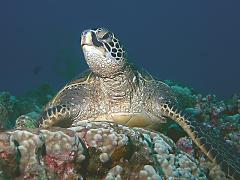
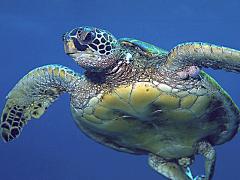
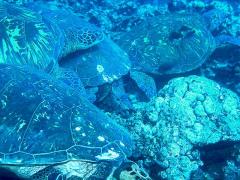
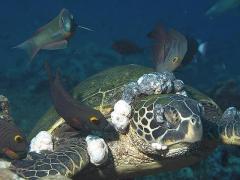
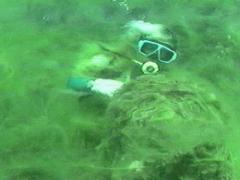
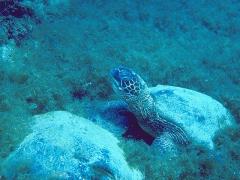
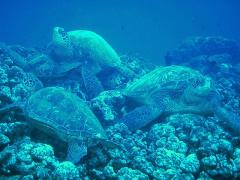
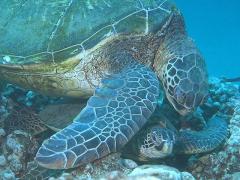
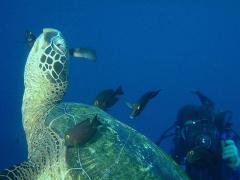
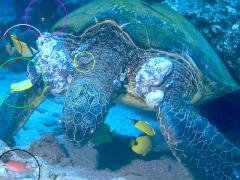
 Saddleback wrasse (T. duperrey)
Saddleback wrasse (T. duperrey) Whitespotted toby (C. jactator)
Whitespotted toby (C. jactator) Long-nosed butterfly (F. flavissimus)
Long-nosed butterfly (F. flavissimus) Millet seed butterfly (C. miliaris)
Millet seed butterfly (C. miliaris) Goldring surgeon (C. strigosus)
Goldring surgeon (C. strigosus) Eight-lined wrasse (Pseudocheilinus octoaenia)
Eight-lined wrasse (Pseudocheilinus octoaenia)